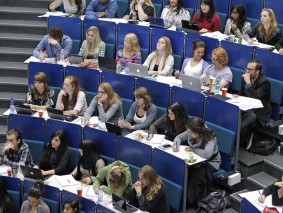About Dr. J. (Joyce) Lebbink, PhD
Introduction
About Joyce
Joyce studied Molecular Sciences (specialty Biochemistry) at the Wageningen University and Research Center in the Netherlands from 1988 to 1994. She obtained her PhD in 1999 at the same University, characterizing molecular details of thermostable enzymes at the Department of Microbiology. She further obtained experience in biophysics and structural biology during her Postdoc at the Center for Structural Biochemistry, Karolinska Institute in Sweden.
In 2002 she returned to the Netherlands as Postdoc in the Protein Crystallography group of Prof. Titia Sixma at the Netherlands Cancer Institute to study structure and mechanisms of DNA Mismatch Repair. Since September 2007 she is further studying mismatch repair and its interactions with homologous recombination at the Department of Molecular Genetics at the Erasmus MC.
Joyce has received Marie-Curie, NWO-VENI and NWO-VIDI personal fellowships and is scientific coordinator of the EU-Marie Curie Training Network “RepState”.
Scientific Coordination
Joyce is Scientific Coordinator of the European Doctoral Network RepState. She also coordinated the European networks DNARepairMan and mismatch2model. All these networks aim to provide the next generation of young scientists with a unique and innovative interdisciplinary training in cutting-edge biophysical research methodologies to address central questions in biology with relevance for human health.
 |
 |
Field(s) of expertise
Research Interest
DNA mismatch repair
DNA mismatch repair (MMR) corrects DNA replication errors and inhibits recombination between DNA with diverging sequences. In both bacteria and eukaryotes, the loss of mismatch repair gives rise to a mutator phenotype. In the most frequent form of familiar cancer, Lynch syndrome, germline mutations in one of the DNA mismatch repair genes predispose to cancer of the colon, endometrium, ovary and other organs.
We would like to understand in mechanistic detail how the recognition of a DNA mismatch during DNA replication or in recombination intermediates results in intramolecular signaling, repair complex formation and ultimately, correct mismatch repair or abortion of the recombination event.
We approach these research questions using a combination of molecular biology, quantitative biochemistry, biophysics and structural biology. We have long-standing collaborations on this subject within the Netherlands (Titia Sixma at NKI, Amsterdam) and abroad (Peter Friedhoff in Giessen, Germany; Terence Strick at CNRS-ENS, Paris).

Expertise
- Protein expression and purification
- Reconstituted MMR assays (DNA binding, DNA incision, DNA unwinding and excision, repair)
- Protein characterization (homogeneity, oligomerization, stability, enzymatic activity)
- Surface plasmon resonance (kinetics of protein-protein and protein-nucleic acids interactions)
- Protein structure prediction and analysis
Current members
Charlie Laffeber, technical expert
Kelly de Koning, technical expert
Kelsey Aguirre Schilder, PhD student
Vaishnavi Bahulekar, PhD student
Romano van Genderen, PhD student
Alumni
Yannicka Mardenborough, PhD student
Pauline Ikpa, technician
Michele Cristovao, postdoc
Nicolaas (Klaas) Hermans, PhD
Khek-Chian (KC) Tham, PhD
Publications
Selected Publications
- Yannicka Mardenborough, Romano M. van Genderen, Charlie Laffeber, Kelly D.A. de Koning, Peter Friedhoff, Roland Kanaar, Martin Depken, Joyce H. G. Lebbink. Tetramerization of the DNA mismatch repair protein MutS enhances daughter strand incision preferentially in the vicinity of replication errors. J. Biol. Chem 2025, in press.
- Raviprasad Kuthethur, Ananya Acharya, Satheesh Sengodan, Carmen Fonseca, Nupur Nagar, Safa Nasri, Oluwakemi Ibini, Eleni-Maria Manolika, Kelly D.A. de Koning, Amélie Fradet-Turcotte, Joyce H.G. Lebbink, Roland Kanaar, Krishna Mohan Poluri, Shyam K. Sharan, Petr Cejka, Arnab Ray Chaudhuri. FIGNL1 inhibits homologous recombination in BRCA2 deficient cells by dissociating RAD51 filaments. Science 2025, 390, doi: 10.1126/science.adt1210.
- Storozhuk, O., Bruekner, S. R., Paul, A., Lebbink, J. H. G., Sixma, T. K. & Friedhoff, P., MutL Activates UvrD by Interaction Between the MutL C-terminal Domain and the UvrD 2B Domain. Journal of Molecular Biology 2024, 436, 168589.
- Borsellini A, Lebbink JHG, Lamers MH. MutL binds to 3’ resected DNA ends and blocks DNA polymerase access. Nucleic Acids Res. 50, 6224-6234, 2022. doi: 10.1093/nar/gkac432.
-
Laffeber C, de Koning K, Kanaar R, Lebbink JHG. Experimental evidence for enhanced receptor binding by rapidly spreading SARS-CoV-2 variants. J. Mol. Biol. 433, 167058, 2021.
Fernandez-Leiro R, Bhairosing-Kok D, Kunetsky V, Laffeber C, Winterwerp HH, Groothuizen F, Fish A, Lebbink JHG, Friedhoff P, Sixma TK, Lamers MH. The selection process of licensing a DNA mismatch for repair. Nature Structural Molecular Biology 2021 Apr;28(4):373-381. doi: 10.1038/s41594-021-00577-7. Epub 2021 Apr 5.PMID: 33820992 - Mardenborough YSN, Nitsenko K, Laffeber C, Duboc C, Sahin E, Quessada-Vial A, Winterwerp HHK, Sixma TK, Kanaar R, Friedhoff P, Strick TR, Lebbink JHG. The unstructured linker arms of MutL enable GATC site incision beyond roadblocks during initiation of DNA mismatch repair. Nucleic Acids Res. 47, 11667-11680, 2019.
- Hermans N, Laffeber C, Cristovão M, Artola-Borán M, Mardenborough Y, Ikpa P, Jaddoe A, Winterwerp HHK, Wyman C, Jiricny J, Kanaar R, Friedhoff P, Lebbink JHG. Dual daughter strand incision is processive and increases the efficiency of DNA mismatch repair. Nucleic Acids Res. 44, 6770-6778, 2016.
- Groothuizen FS, Winkler I, Cristóvão M, Fish A, Winterwerp HHK, Reumer A, Marx AD, Hermans N, Nicholls RA, Murshudov GN, Lebbink JHG, Friedhoff P, Sixma TK. MutS/MutL crystal structure reveals that the MutS sliding clamp loads MutL onto DNA. eLife 10.7554/eLife.06744, 2015.
- Tham KC, Hermans N, Winterwerp HHK, Cox MC, Wyman C, Kanaar R and Lebbink JHG. Mismatch Repair Inhibits Homeologous Recombination via Coordinated Directional Unwinding of Trapped DNA Structures. Mol. Cell. 51, 326-337, 2013.
- Groothuizen FS, Fish A, Petoukhov MV, Reumer A, Manelyte L, Winterwerp HHK, Marinus MG, Lebbink JHG, Svergun DI, Friedhoff P and Sixma TK. Using stable MutS dimers and tetramers to quantitatively analyze DNA mismatch recognition and sliding clamp formation. Nucleic Acids Res. 14, 8166-8181, 2013.
Teaching activities
- B.Sc Nanobiology, NB2230 Biomolecular Structure and Function
- M.Sc. Nanobiology, NB4030 Engineering Genetic Information

MEP Projects
Molecular mechanism underlying mismatch specificity of MutS during DNA mismatch repair
DNA mismatch repair (MMR) maintains genome stability by repairing DNA replication errors such as DNA mismatches. In E. coli, MMR is initiated by MutS, MutL and MutH. MutS recognizes the mismatch and upon binding of ATP, forms a sliding clamp which recruits MutL, leading to MutH activation and DNA strand incision at a hemimethylated GATC site.
To understand how MutS attains mismatch specificity, we create mutations at the interface of its mismatch binding and connector domain. These MutS variants loose mismatch specificity and activate MMR on DNA without errors. Using biochemical and biophysical approaches we will characterize the conformational transitions in wild type and mutant MutS, to understand the molecular mechanism underlying mismatch specificity.
Techniques/Methods
Site-directed mutagenesis, protein expression, protein purification using affinity and ion exchange chromatography, kinetics and affinity of DNA binding using Surface Plasmon Resonance, DNA incision assays.Literature

Coordination of mismatch repair by MutSα ATPase activity
The DNA mismatch repair (MMR) system corrects mismatches and small insertion/deletion loops that arise during DNA replication. In humans, MMR is initiated when the MutSα complex recognizes a DNA mismatch in the newly replicated DNA. This complex recruit MutLα, which contains the endonuclease activity and coordinates the incision of the error-containing strand, followed by excision of the error and resynthesis and ligation to restore the correct DNA sequence.
Mutations affecting critical residues in the ATPase domain of MutSα from yeast have been shown to impair ATP binding, hydrolysis and sliding clamp formation, which are essential steps for effective mismatch recognition and repair. These residues are conserved in the human homolog. In this project we will construct ATPase mutants in human MutSα and use biochemical approaches to study their effect on the different MMR reactions steps.
Approach:
- Expression of recombinant proteins in Sf9 insect cells using the baculovirus system.
- Purification of proteins.
- Biochemical DNA incision and excision assays to determine the activity and possible functional differences between MutSα wildtype and mutants.
Literature
Understanding the effect of MutLα mutations on human DNA Mismatch Repair
The DNA mismatch repair (MMR) system corrects mismatches and small insertion/deletion loops that arise during DNA replication. In humans, MMR is initiated when the MutSα complex recognizes a DNA mismatch in the newly replicated DNA. This complex recruit MutLα (composed of MLH1 and PMS2 subunits), which contains the endonuclease activity and coordinates the incision of the error-containing strand, followed by excision of the error and resynthesis and ligation to restore the correct DNA sequence.
Loss-of-function mutations in MMR proteins result in the accumulation of mutations throughout the genome and are a major cause of Lynch syndrome (hereditary nonpolyposis colorectal cancer), which predisposes to colorectal and other cancers. In this project we will characterize some of these disease-associated variants, particularly in the MLH1 and PMS2 subunits of MutLα, possibly disrupting its endonuclease function or impair its interaction with other MMR proteins. Using biochemically reconstituted MMR assays, we aim to learn how these residues contribute to the molecular mechanism of mismatch repair.
Approach
- Expression of recombinant proteins in Sf9 insect cells using the baculovirus system.
- Purification of proteins.
- Biochemical DNA incision assays to determine the activity and possible functional differences between MutLα wild type and mutants.
Literature
Roles of Canonical and Alternative RPA in DNA Mismatch Repair
Replication Protein A (RPA), composed of the subunits RPA1, RPA2, and RPA3, is a key player in mismatch repair. Beyond its essential role in DNA replication, RPA can melt unusual DNA structures and modulate nuclease activities. In primates, there is an alternative isoform known as Alternative-RPA (Alt-RPA), which consists of RPA1, RPA3, and a primate-specific RPA4 subunit replacing RPA2. Interestingly, both RPA and Alt-RPA are upregulated in Huntington’s disease, a disorder caused by expansions of CAG trinucleotide repeats.
Preliminary in vitro experiments using RPA-depleted extracts suggest that low levels of either RPA or Alt-RPA can enhance GT mismatch repair. However, increasing RPA levels further stimulates GT repair, while increasing Alt-RPA has the opposite effect, reducing mismatch repair efficiency. Together, these observations suggest that RPA and Alt-RPA may differentially regulate MMR activity. In this project we aim to characterize at which reaction steps this antagonistic regulation takes place.
Approach
- Prediction of potential interactions using structural analysis and AlphaFold modeling.
- Expression of recombinant proteins in Sf9 insect cells using the baculovirus system.
- Purification of proteins.
- Biochemical MMR excision assays to determine the activity and possible functional differences between RPA, Alt-RPA and variants carrying interface mutations.






